Shiqi Gong
Physical-Layer Security in Mixed Near-Field and Far-Field Communication Systems
Apr 28, 2025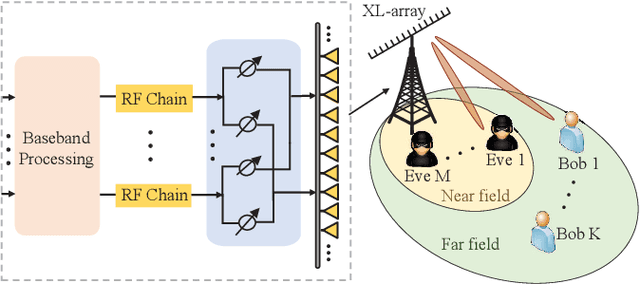
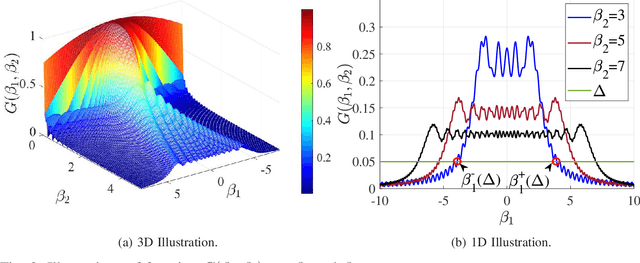

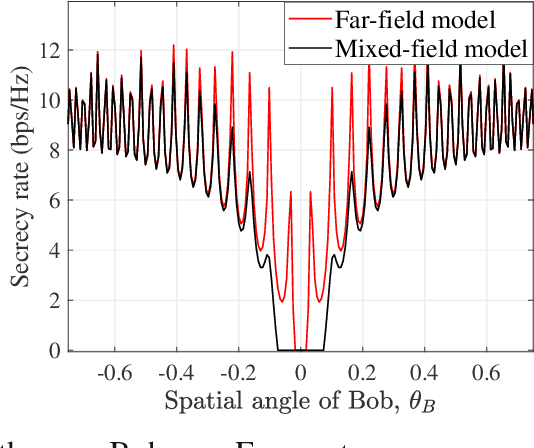
Abstract:Extremely large-scale arrays (XL-arrays) have emerged as a promising technology to improve the spectrum efficiency and spatial resolution of future wireless systems. Different from existing works that mostly considered physical layer security (PLS) in either the far-field or near-field, we consider in this paper a new and practical scenario, where legitimate users (Bobs) are located in the far-field of a base station (BS) while eavesdroppers (Eves) are located in the near-field for intercepting confidential information at short distance, referred to as the mixed near-field and far-field PLS. Specifically, we formulate an optimization problem to maximize the sum-secrecy-rate of all Bobs by optimizing the power allocation of the BS, subject to the constraint on the total BS transmit power. To shed useful insights, we first consider a one-Bob-one-Eve system and characterize the insecure-transmission region of the Bob in closed form. Interestingly, we show that the insecure-transmission region is significantly \emph{expanded} as compared to that in conventional far-field PLS systems, due to the energy-spread effect in the mixed-field scenario. Then, we further extend the analysis to a two-Bob-one-Eve system. It is revealed that as compared to the one-Bob system, the interferences from the other Bob can be effectively used to weaken the capability of Eve for intercepting signals of target Bobs, thus leading to enhanced secrecy rates. Furthermore, we propose an efficient algorithm to obtain a high-quality solution to the formulated non-convex problem by leveraging the successive convex approximation (SCA) technique. Finally, numerical results demonstrate that our proposed algorithm achieves a higher sum-secrecy-rate than the benchmark scheme where the power allocation is designed based on the (simplified) far-field channel model.
Bayesian Sensing for Time-Varying Channels in ISAC Systems
Apr 21, 2025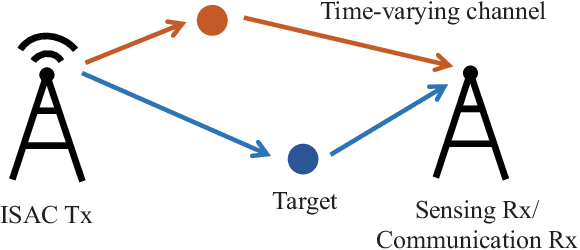
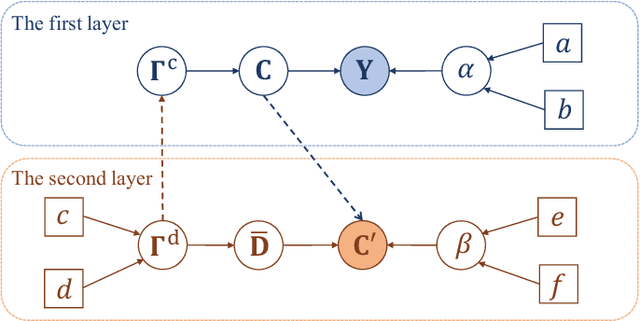
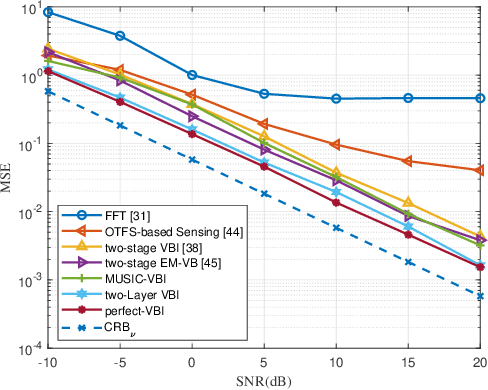
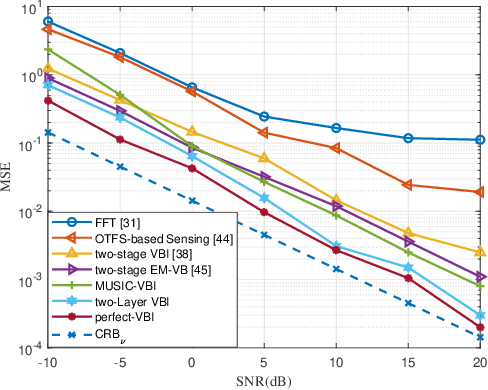
Abstract:Future mobile networks are projected to support integrated sensing and communications in high-speed communication scenarios. Nevertheless, large Doppler shifts induced by time-varying channels may cause severe inter-carrier interference (ICI). Frequency domain shows the potential of reducing ISAC complexity as compared with other domains. However, parameter mismatching issue still exists for such sensing. In this paper, we develop a novel sensing scheme based on sparse Bayesian framework, where the delay and Doppler estimation problem in time-varying channels is formulated as a 3D multiple measurement-sparse signal recovery (MM-SSR) problem. We then propose a novel two-layer variational Bayesian inference (VBI) method to decompose the 3D MM-SSR problem into two layers and estimate the Doppler in the first layer and the delay in the second layer alternatively. Subsequently, as is benefited from newly unveiled signal construction, a simplified two-stage multiple signal classification (MUSIC)-based VBI method is proposed, where the delay and the Doppler are estimated by MUSIC and VBI, respectively. Additionally, the Cram\'er-Rao bound (CRB) of the considered sensing parameters is derived to characterize the lower bound for the proposed estimators. Corroborated by extensive simulation results, our proposed method can achieve improved mean square error (MSE) than its conventional counterparts and is robust against the target number and target speed, thereby validating its wide applicability and advantages over prior arts.
Multi-Carrier Faster-Than-Nyquist Signaling for OTFS Systems
Jan 12, 2025



Abstract:Orthogonal time frequency space (OTFS) modulation technique is promising for high-mobility applications to achieve reliable communications. However, the capacity of OTFS systems is generally limited by the Nyquist criterion, requiring orthogonal pulses in both time and frequency domains. In this paper, we propose a novel multi-carrier faster-than-Nyquist (MC-FTN) signaling scheme for OTFS systems. By adopting non-orthogonal pulses in both time and frequency domains, our scheme significantly improves the capacity of OTFS systems. Specifically, we firstly develop the signal models for both single-input single-output (SISO) and multiple-input multiple-output (MIMO) OTFS systems. Then, we optimize the delay-Doppler (DD) domain precoding matrix at the transmitter to suppress both the inter-symbol interference (ISI) and inter-carrier interference (ICI) introduced by the MC-FTN signaling. For SISO systems, we develop an eigenvalue decomposition (EVD) precoding scheme with optimal power allocation (PA) for achieving the maximum capacity. For MIMO systems, we develop a successive interference cancellation (SIC)-based precoding scheme via decomposing the capacity maximization problem into multiple sub-capacity maximization problems with largely reduced dimensions of optimization variables. Numerical results demonstrate that our proposed MC-FTN-OTFS signaling scheme achieves significantly higher capacity than traditional Nyquist-criterion-based OTFS systems. Moreover, the SIC-based precoding scheme can effectively reduce the complexity of MIMO capacity maximization, while attaining performance close to the optimal EVD-based precoding scheme.
Frequency Diverse Array-enabled RIS-aided Integrated Sensing and Communication
Oct 01, 2024Abstract:Integrated sensing and communication (ISAC) has been envisioned as a prospective technology to enable ubiquitous sensing and communications in next-generation wireless networks. In contrast to existing works on reconfigurable intelligent surface (RIS) aided ISAC systems using conventional phased arrays (PAs), this paper investigates a frequency diverse array (FDA)-enabled RIS-aided ISAC system, where the FDA aims to provide a distance-angle-dependent beampattern to effectively suppress the clutter, and RIS is employed to establish high-quality links between the BS and users/target. We aim to maximize sum rate by jointly optimizing the BS transmit beamforming vectors, the covariance matrix of the dedicated radar signal, the RIS phase shift matrix, the FDA frequency offsets and the radar receive equalizer, while guaranteeing the required signal-to-clutter-plus-noise ratio (SCNR) of the radar echo signal. To tackle this challenging problem, we first theoretically prove that the dedicated radar signal is unnecessary for enhancing target sensing performance, based on which the original problem is much simplified. Then, we turn our attention to the single-user single-target (SUST) scenario to demonstrate that the FDA-RIS-aided ISAC system always achieves a higher SCNR than its PA-RIS-aided counterpart. Moreover, it is revealed that the SCNR increment exhibits linear growth with the BS transmit power and the number of BS receive antennas. In order to effectively solve this simplified problem, we leverage the fractional programming (FP) theory and subsequently develop an efficient alternating optimization (AO) algorithm based on symmetric alternating direction method of multipliers (SADMM) and successive convex approximation (SCA) techniques. Numerical results demonstrate the superior performance of our proposed algorithm in terms of sum rate and radar SCNR.
Channel Estimation for XL-IRS Assisted Wireless Systems with Double-sided Visibility Regions
Aug 30, 2024



Abstract:In this paper, we study efficient channel estimation design for an extremely large-scale intelligent reflecting surface (XL-IRS) assisted multi-user communication systems, where both the base station (BS) and users are located in the near-field region of the XL-IRS. Two unique channel characteristics of XL-IRS are considered, namely, the near-field spherical wavefronts and double-sided visibility regions (VRs) at the BS and users, which render the channel estimation for XL-IRS highly challenging. To address this issue, we propose in this paper an efficient three-step XL-IRS channel estimation method. Specifically, in the first step, an anchor node is delicately deployed near the XL-IRS to estimate the cascaded BS-IRS-anchor channel. Then, an efficient VR detection method is devised to estimate the VR information between the BS and XL-IRS. In this way, only the channels from the visible XL-IRS elements to the BS are estimated, thereby reducing the dimension of the cascaded BS-IRS-users channels to be estimated. Third, by leveraging the common BS-IRS channel, the cascaded channels for all users are consecutively estimated accounting for the VRs of the IRS-user channels. Finally, numerical results are provided to demonstrate the effectiveness of our proposed channel estimation scheme as compared to various benchmark schemes.
Massive MIMO-OTFS-Based Random Access for Cooperative LEO Satellite Constellations
Aug 05, 2024



Abstract:This paper investigates joint device identification, channel estimation, and symbol detection for cooperative multi-satellite-enhanced random access, where orthogonal time-frequency space modulation with the large antenna array is utilized to combat the dynamics of the terrestrial-satellite links (TSLs). We introduce the generalized complex exponential basis expansion model to parameterize TSLs, thereby reducing the pilot overhead. By exploiting the block sparsity of the TSLs in the angular domain, a message passing algorithm is designed for initial channel estimation. Subsequently, we examine two cooperative modes to leverage the spatial diversity within satellite constellations: the centralized mode, where computations are performed at a high-power central server, and the distributed mode, where computations are offloaded to edge satellites with minimal signaling overhead. Specifically, in the centralized mode, device identification is achieved by aggregating backhaul information from edge satellites, and channel estimation and symbol detection are jointly enhanced through a structured approximate expectation propagation (AEP) algorithm. In the distributed mode, edge satellites share channel information and exchange soft information about data symbols, leading to a distributed version of AEP. The introduced basis expansion model for TSLs enables the efficient implementation of both centralized and distributed algorithms via fast Fourier transform. Simulation results demonstrate that proposed schemes significantly outperform conventional algorithms in terms of the activity error rate, the normalized mean squared error, and the symbol error rate. Notably, the distributed mode achieves performance comparable to the centralized mode with only two exchanges of soft information about data symbols within the constellation.
Robust Beamforming Design and Antenna Selection for Dynamic HRIS-aided Massive MIMO Systems
Mar 31, 2024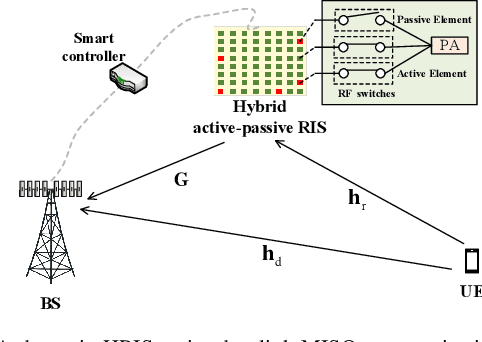
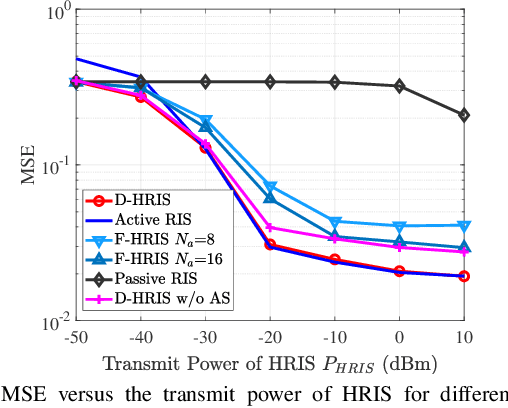
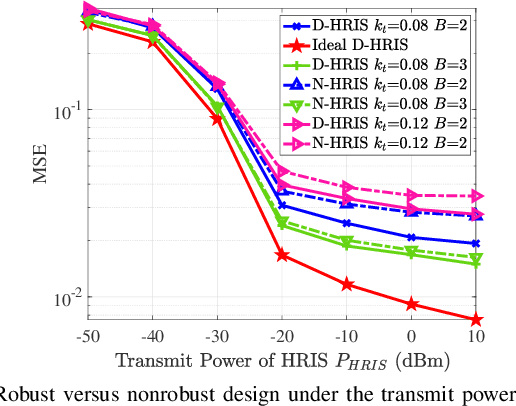
Abstract:In this paper, a dynamic hybrid active-passive reconfigurable intelligent surface (HRIS) is proposed to further enhance the massive multiple-input-multiple-output (MIMO) system, since it supports the dynamic placement of active and passive elements. Specifically, considering the impact of the hardware impairments (HWIs), we investigate the channel-aware configuration of the receive antennas at the base station (BS) and the active/passive elements at the HRIS to improve the reliability of system. To this end, we investigate the average mean-square-error (MSE) minimization problem for the HRIS-aided massive MIMO system by jointly optimizing the BS receive antenna selection matrix, the reflection phase coefficients, the reflection amplitude matrix, and the mode selection matrix of the HRIS under the power budget of the HRIS. To tackle the non-convexity and intractability of this problem, we first transform the binary and discrete variables into continuous ones, and then propose a penalty-based exact block coordinate descent (BCD) algorithm to solve these subproblems alternately. Numerical simulations demonstrate the great superiority of the proposed scheme over the conventional benchmark schemes.
Joint Beamforming Optimization and Mode Selection for RDARS-aided MIMO Systems
Jan 20, 2024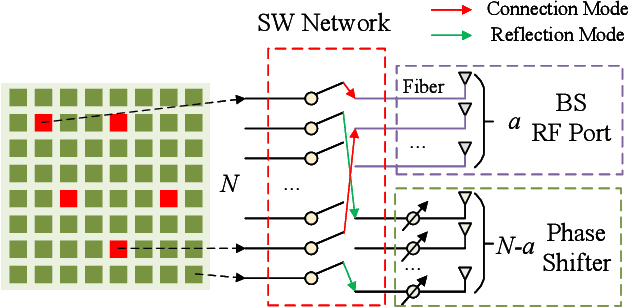
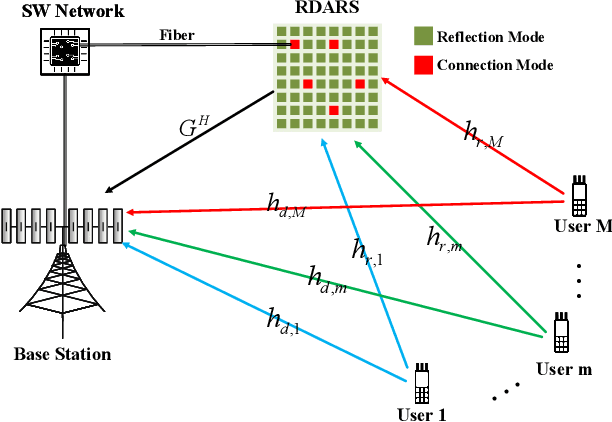
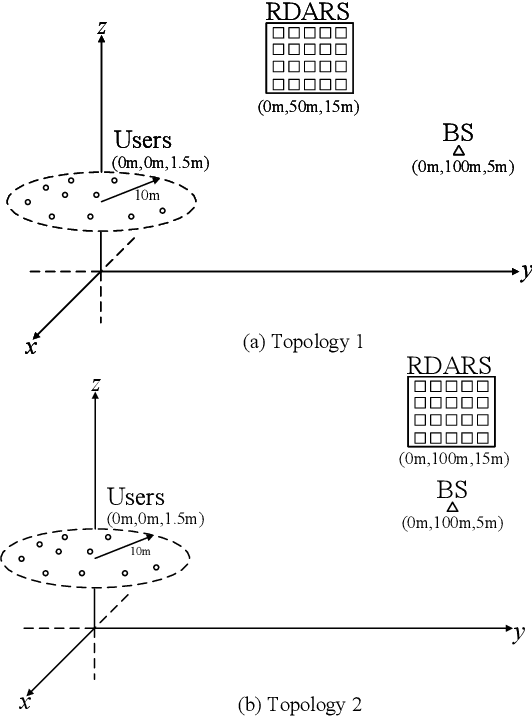
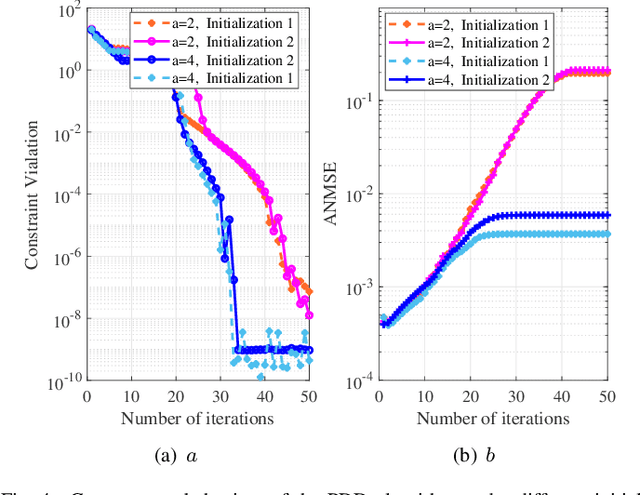
Abstract:Considering the appealing distribution gains of distributed antenna systems (DAS) and passive gains of reconfigurable intelligent surface (RIS), a flexible reconfigurable architecture called reconfigurable distributed antenna and reflecting surface (RDARS) is proposed. RDARS encompasses DAS and RIS as two special cases and maintains the advantages of distributed antennas while reducing the hardware cost by replacing some active antennas with low-cost passive reflecting surfaces. In this paper, we present a RDARS-aided uplink multi-user communication system and investigate the system transmission reliability with the newly proposed architecture. Specifically, in addition to the distribution gain and the reflection gain provided by the connection and reflection modes, respectively, we also consider the dynamic mode switching of each element which introduces an additional degree of freedom (DoF) and thus results in a selection gain. As such, we aim to minimize the total sum mean-square-error (MSE) of all data streams by jointly optimizing the receive beamforming matrix, the reflection phase shifts and the channel-aware placement of elements in the connection mode. To tackle this nonconvex problem with intractable binary and cardinality constraints, we propose an inexact block coordinate descent (BCD) based penalty dual decomposition (PDD) algorithm with the guaranteed convergence. Since the PDD algorithm usually suffers from high computational complexity, a low-complexity greedy-search-based alternating optimization (AO) algorithm is developed to yield a semi-closed-form solution with acceptable performance. Numerical results demonstrate the superiority of the proposed architecture compared to the conventional fully passive RIS or DAS. Furthermore, some insights about the practical implementation of RDARS are provided.
Dual-Functional MIMO Beamforming Optimization for RIS-Aided Integrated Sensing and Communication
Jul 17, 2023
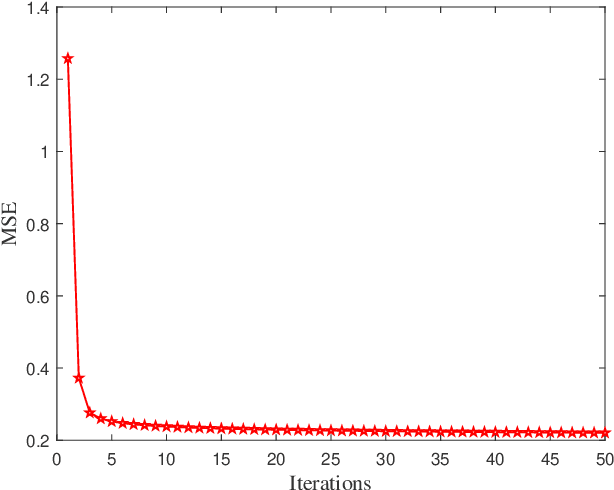
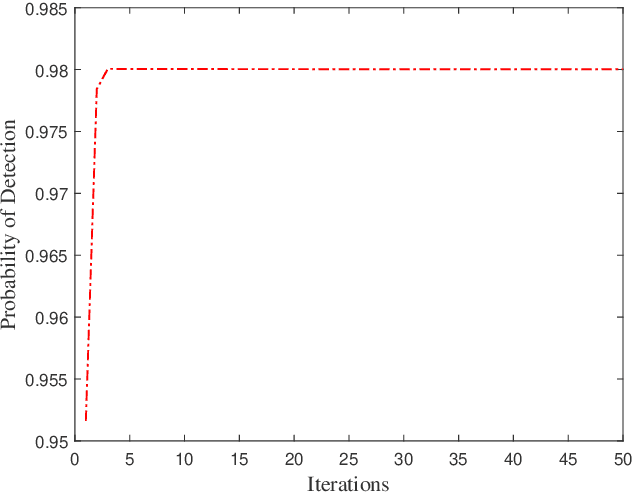
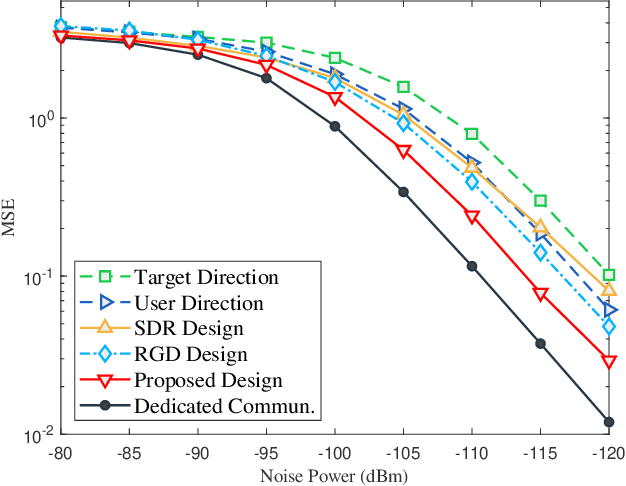
Abstract:Aiming at providing wireless communication systems with environment-perceptive capacity, emerging integrated sensing and communication (ISAC) technologies face multiple difficulties, especially in balancing the performance trade-off between the communication and radar functions. In this paper, we introduce a reconfigurable intelligent surface (RIS) to assist both data transmission and target detection in a dual-functional ISAC system. To formulate a general optimization framework, diverse communication performance metrics have been taken into account including famous capacity maximization and mean-squared error (MSE) minimization. Whereas the target detection process is modeled as a general likelihood ratio test (GLRT) due to the practical limitations, and the monotonicity of the corresponding detection probability is proved. For the single-user and single-target (SUST) scenario, the minimum transmit power of the ISAC transceiver has been revealed. By exploiting the optimal conditions of the BS design, we validate that the BS is able to realize the maximum power allocation scheme and derive the optimal BS precoder in a semi-closed form. Moreover, an alternating direction method of multipliers (ADMM) based RIS design is proposed to address the optimization of unit-modulus RIS phase shifts. For the sake of further enhancing computational efficiency, we also develop a low-complexity RIS design based on Riemannian gradient descent. Furthermore, the ISAC transceiver design for the multiple-users and multiple-targets (MUMT) scenario is also investigated, where a zero-forcing (ZF) radar receiver is adopted to cancel the interferences. Then optimal BS precoder is derived under the maximum power allocation scheme, and the RIS phase shifts can be optimized by extending the proposed ADMM-based RIS design. Numerical simulation results verify the performance of our proposed transceiver designs.
RIS-Aided MIMO Systems with Hardware Impairments: Robust Beamforming Design and Analysis
Sep 23, 2022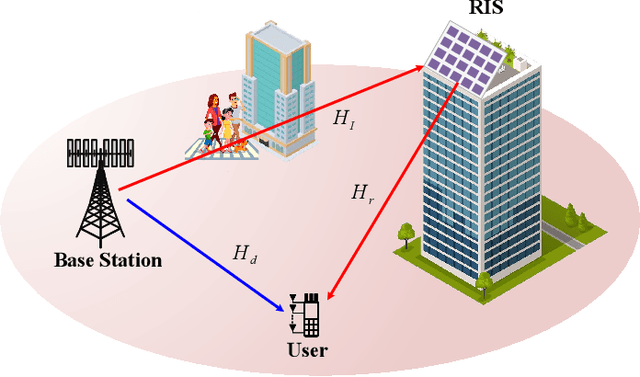
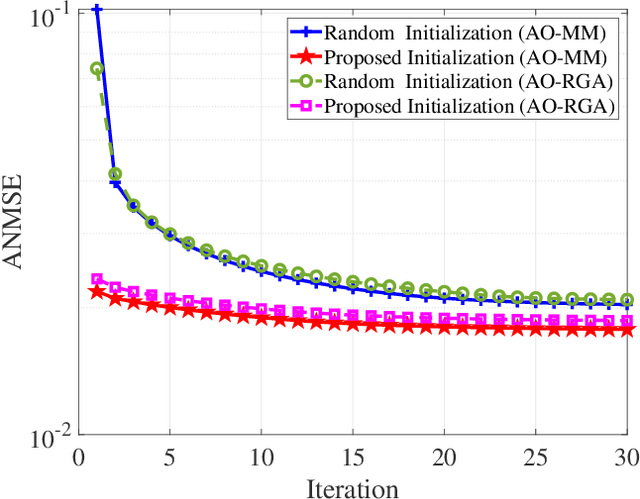
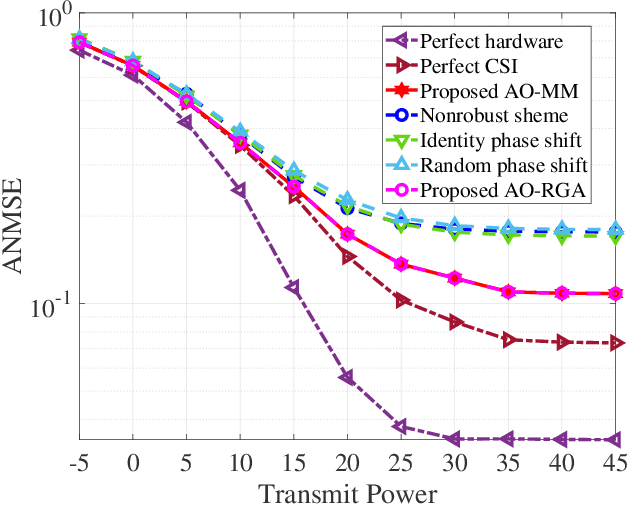
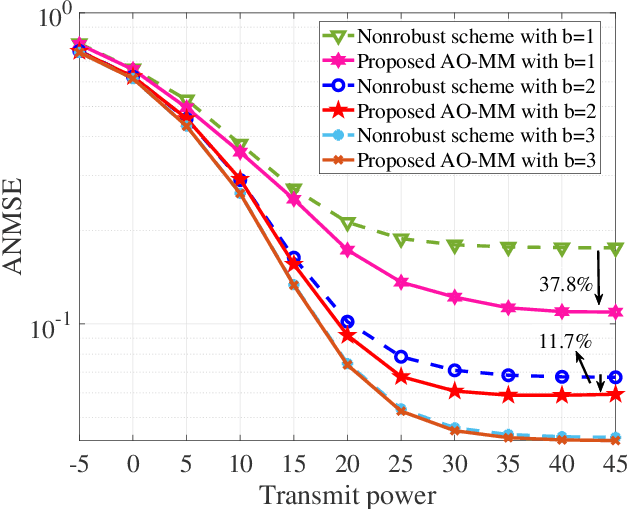
Abstract:Reconfigurable intelligent surface (RIS) has been anticipated to be a novel cost-effective technology to improve the performance of future wireless systems. In this paper, we investigate a practical RIS-aided multiple-input-multiple-output (MIMO) system in the presence of transceiver hardware impairments, RIS phase noise and imperfect channel state information (CSI). Joint design of the MIMO transceiver and RIS reflection matrix to minimize the total average mean-square-error (MSE) of all data streams is particularly considered. This joint design problem is non-convex and challenging to solve due to the newly considered practical imperfections. To tackle the issue, we first analyze the total average MSE by incorporating the impacts of the above system imperfections. Then, in order to handle the tightly coupled optimization variables and non-convex NP-hard constraints, an efficient iterative algorithm based on alternating optimization (AO) framework is proposed with guaranteed convergence, where each subproblem admits a closed-form optimal solution by leveraging the majorization-minimization (MM) technique. Moreover, via exploiting the special structure of the unit-modulus constraints, we propose a modified Riemannian gradient ascent (RGA) algorithm for the discrete RIS phase shift optimization. Furthermore, the optimality of the proposed algorithm is validated under line-of-sight (LoS) channel conditions, and the irreducible MSE floor effect induced by imperfections of both hardware and CSI is also revealed in the high signal-to-noise ratio (SNR) regime. Numerical results show the superior MSE performance of our proposed algorithm over the adopted benchmark schemes, and demonstrate that increasing the number of RIS elements is not always beneficial under the above system imperfections.
 Add to Chrome
Add to Chrome Add to Firefox
Add to Firefox Add to Edge
Add to Edge